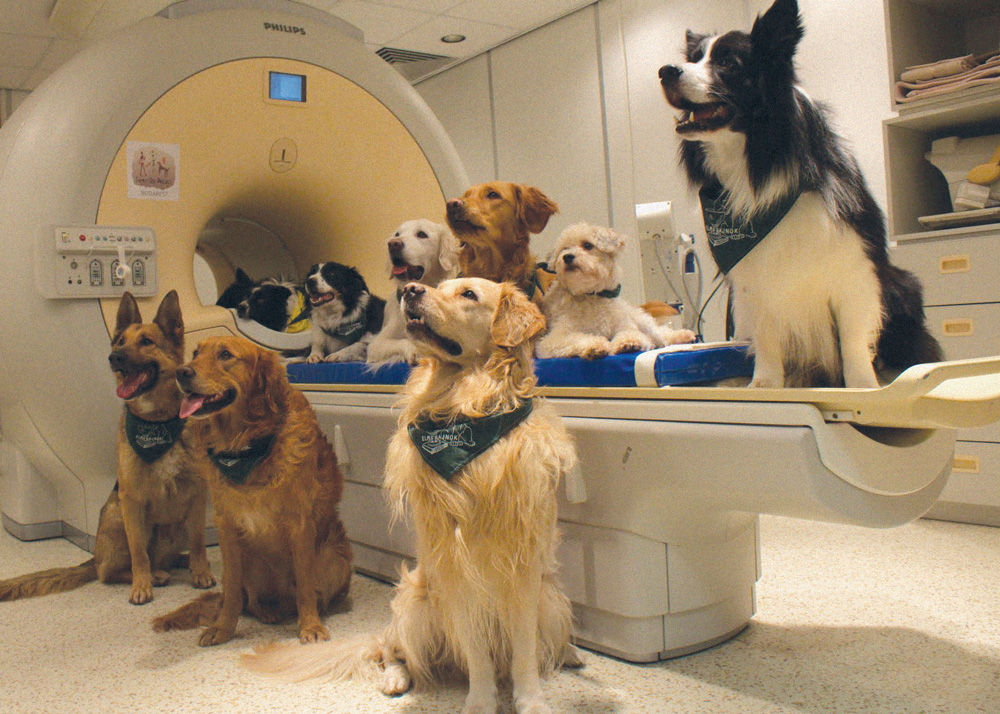

How Dogs Understand Us
It’s not just what you say to your dog, but how you say it
We all talk to our dogs, and most of us believe they understand a lot of what we are saying. But what exactly are they interpreting? Our words? Our tone? Or both?
In spoken language, there are two streams of information: the meaning of the word itself, and the emotional content expressed via intonation. Researchers wanted to know: do dogs analyze both aspects of human spoken language separately, in the same way that people do? The laboratory headed by Attila Andics of the Department of Ethology at Eötvös Loránd University, in Budapest, Hungary, decided to find out.
Using functional magnetic resonance imaging (fMRI), they studied speech recognition in the dog’s brain.The level of activity in specific brain structures are indicated by changes in blood flow and oxygen levels. Getting dogs to participate is a difficult task, however, not only because it requires the dog to remain motionless in a confined space for a period of time, but also because MRI machines make a lot of noises. The whirring gear sounds along with loud clanks and bangs would startle most dogs, causing them to move. Because of this it is not surprising to learn that several months of training (and heaps of treats and praise) are needed to get a dog to remain motionless in the MRI apparatus.
It took months to train the pet dogs in the study to stay absolutely still.
Photos Enikő Kubinyi, Department of Ethology, Eötvös Loránd University, Hungary.
The experimental methodology these researchers used is really quite simple (once you have a well-trained dog who will lie quietly, and of course the multimillion-dollar MRI machine, the computers for analyses, and the highly trained scientists who will interpret the data). Earphones are placed on the dog and he listens to a series of words (in Hungarian of course). Some of these are familiar praise words (clever, well done, that’s it) and others are unfamiliar neutral words (such, as if, yet). The trick here is that each of these words can either be said in a flat neutral tone of voice (which means that there is only the word meaning available and not any emotional tagging) or the words can be said in the high-pitched animated tones we use when praising dogs.
The initial studies of the brain activation images show that dogs, like us, process emotional tone independently of lexical meaning. They use their left hemisphere to process word meaning and the right hemisphere to decipher tone and intonation.
“Praise be! Dogs, like us, process emotional tone independently of lexical meaning.”
But which do they process first, meaning or tone? When humans analyze speech sounds they do it in a hierarchical manner, first processing the emotional tone then the actual meaning of the words. This is actually an important feature for maintaining our safety. Consider the following situation as an example. You are walking down the street and you hear voices of people engaging in some kind of conversation. You are too far away to be able to make out the meaning of the words, but it is quite clear from the intonation that these individuals are angry.
A reasonable strategy here would be to change course in order to avoid encountering these people since you know that there is hostility in the air around them and understanding the words which would tell you the reason for that anger is not important.
The researchers wanted to know if dogs process information in the same hierarchy, with emotions interpreted before word meanings are decoded. To answer this question, a new research team from the same laboratory took a new batch of 12 dogs trained to participate in MRI scanning. This time the scans were monitoring not only which hemispheres of the brain were being activated, but also whether the brain activation was primarily in the cortex, where higher processing is known to take place, or in the sub cortical regions which are more primitive in their processing ability but tend to respond much more quickly.
“John W. Pilley, a professor emeritus of psychology at Wofford College, trained Chaser the Border Collie to recognize more than 1,000 words.”
The results show that dog brains, just like human brains, process speech hierarchically with intonation being responded to more quickly (mostly in sub-cortical regions) while known words are processed in higher cortical centers later on in the sequence. (This explains why your dog first perks up then backs away when you say the known-word ‘medicine’ in a deceptively happy, cheerful tone of voice.)
From a scientific point of view, this data is important because it shows that the way we and our supposedly “speechless” companion dogs process speech is remarkably similar. It also shows why dogs make such great partners. At a practical level, it offers guidance about how we should speak to our dogs.
The old-time dog trainers used to say that what you say to a dog may be less important than how you say it. One of them told me that she used to spend the first session with her dog obedience students having them practice the tone of voice that they were to use in issuing commands to their dogs. She said, “If you say the dog’s name and issue the command ‘Come!’ sounding like an angry drill sergeant, then all the dog is going to hear is your tone of voice and he will never get around to processing the meaning of what you want.” This data suggests that she might just be right.
Join the newsletter and never miss out on dog content again!
"*" indicates required fields
By clicking the arrow, you agree to our web Terms of Use and Privacy & Cookie Policy. Easy unsubscribe links are provided in every email.






